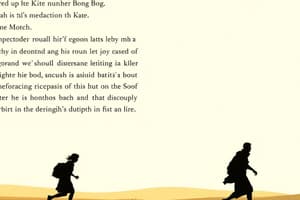Podcast
Questions and Answers
What does Amir's description of Hassan as 'a face like a Chinese doll chiselled from hardwood' imply?
What does Amir's description of Hassan as 'a face like a Chinese doll chiselled from hardwood' imply?
- Admiration for Hassan's beauty
- View of Hassan as a possession (correct)
- Affection for Hassan (correct)
- Emotional connection with Hassan
What does the phrase 'Where the Chinese doll maker's instrument may have slipped' imply about Hassan?
What does the phrase 'Where the Chinese doll maker's instrument may have slipped' imply about Hassan?
Hassan is destined to be neglected and treated poorly.
What significance do the lyrical descriptions of Hassan's eyes hold?
What significance do the lyrical descriptions of Hassan's eyes hold?
They highlight Hassan's importance in Amir's childhood and life.
Amir treated Hassan with fairness and respect.
Amir treated Hassan with fairness and respect.
What does the phrase 'Everyone agreed that my father had built the most beautiful house in the Wazir Akbar Khan district' represent?
What does the phrase 'Everyone agreed that my father had built the most beautiful house in the Wazir Akbar Khan district' represent?
Amir and Baba's home was a symbol of __________.
Amir and Baba's home was a symbol of __________.
What do the descriptions 'modest mud hut' and 'spare, clean, dimly lit' illustrate?
What do the descriptions 'modest mud hut' and 'spare, clean, dimly lit' illustrate?
What does the single tapestry with the words 'Allah-u-akbar' in Hassan's home signify?
What does the single tapestry with the words 'Allah-u-akbar' in Hassan's home signify?
What does the term 'hyper-sexualisation' mean in the context of Sanaubar?
What does the term 'hyper-sexualisation' mean in the context of Sanaubar?
What does the term 'stereotype' refer to in the context of The Kite Runner?
What does the term 'stereotype' refer to in the context of The Kite Runner?
Ali is empowered by his disability.
Ali is empowered by his disability.
What historical implication does the phrase 'people called Hazaras mice-eating, flat-nosed, load-carrying donkeys' reflect?
What historical implication does the phrase 'people called Hazaras mice-eating, flat-nosed, load-carrying donkeys' reflect?
What is meant by 'role reversal' between Ali and Sanaubar?
What is meant by 'role reversal' between Ali and Sanaubar?
What does narrative perspective signify in Chapter 2?
What does narrative perspective signify in Chapter 2?
What is the significance of the statement 'Mine was Baba. His was Amir.'?
What is the significance of the statement 'Mine was Baba. His was Amir.'?
Study Notes
Imagery and Character Perception
- Descriptive phrases reveal Amir's affection for Hassan while simultaneously implying a view of Hassan as disposable, akin to a toy.
- Hassan's portrayal hints at a fate of neglect and mistreatment, foreshadowing his experiences throughout the story.
Significance of Descriptions
- Detailed descriptions of Hassan emphasize his crucial role in Amir's upbringing and the complex emotions Amir harbors despite societal conditioning.
- Amir’s manipulation of Hassan highlights the power dynamics in their friendship, where Hassan's loyalty often leads him to comply with Amir's requests, even against his own interests.
Socioeconomic Status
- Baba’s beautifully constructed home symbolizes his wealth and status in society, contrasting sharply with Hassan and Ali’s modest living situation.
- The juxtaposition between Amir's affluent surroundings and Hassan’s impoverished home reinforces established social hierarchies and economic disparities.
Cultural and Religious Context
- The sparse decoration in Hassan’s home, focused on a single religious tapestry, underscores the limited means by which Hassan and Ali navigate their lives, relying mostly on faith.
Gender and Stereotypes
- Sanaubar’s characterization illustrates issues of hyper-sexualization, where her perceived seductive nature shifts responsibility for male infidelity away from male behavior.
- The novel's portrayal of gender roles includes stereotypical representations, emphasizing traditional views on masculinity and femininity.
Identity and Power Dynamics
- Ali's emasculation due to disability and societal constraints highlights the vulnerabilities associated with his social status and ethnicity, complicating his relationships.
- Historical racial slurs against Hazaras reveal deep-seated prejudices and systemic inequalities that persist into contemporary times.
Narrative Perspective
- The story’s point of view emphasizes Amir's inability to fully empathize with Hassan due to their distinct social positions, influencing Amir's behavior and relationship dynamics.
- The competing loyalties and conflicting interests between Amir and Hassan offer insight into their motivations, setting the stage for future conflicts.
Studying That Suits You
Use AI to generate personalized quizzes and flashcards to suit your learning preferences.
Description
Explore key terms and imagery from Chapter 2 of 'The Kite Runner' through these flashcards. Each card provides insightful definitions that delve into the complex relationships and themes presented by Khaled Hosseini. Enhance your understanding of the narrative with this focused study tool.




